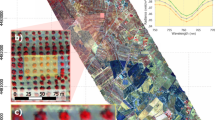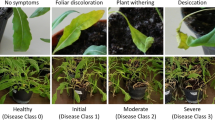Abstract
Plant pathogens cause significant losses to agricultural yields and increasingly threaten food security1, ecosystem integrity and societies in general2,3,4,5. Xylella fastidiosa is one of the most dangerous plant bacteria worldwide, causing several diseases with profound impacts on agriculture and the environment6. Primarily occurring in the Americas, its recent discovery in Asia and Europe demonstrates that X. fastidiosa’s geographic range has broadened considerably, positioning it as a reemerging global threat that has caused socioeconomic and cultural damage7,8. X. fastidiosa can infect more than 350 plant species worldwide9, and early detection is critical for its eradication8. In this article, we show that changes in plant functional traits retrieved from airborne imaging spectroscopy and thermography can reveal X. fastidiosa infection in olive trees before symptoms are visible. We obtained accuracies of disease detection, confirmed by quantitative polymerase chain reaction, exceeding 80% when high-resolution fluorescence quantified by three-dimensional simulations and thermal stress indicators were coupled with photosynthetic traits sensitive to rapid pigment dynamics and degradation. Moreover, we found that the visually asymptomatic trees originally scored as affected by spectral plant-trait alterations, developed X. fastidiosa symptoms at almost double the rate of the asymptomatic trees classified as not affected by remote sensing. We demonstrate that spectral plant-trait alterations caused by X. fastidiosa infection are detectable previsually at the landscape scale, a critical requirement to help eradicate some of the most devastating plant diseases worldwide.
This is a preview of subscription content, access via your institution
Access options
Access Nature and 54 other Nature Portfolio journals
Get Nature+, our best-value online-access subscription
$29.99 / 30 days
cancel any time
Subscribe to this journal
Receive 12 digital issues and online access to articles
$119.00 per year
only $9.92 per issue
Buy this article
- Purchase on Springer Link
- Instant access to full article PDF
Prices may be subject to local taxes which are calculated during checkout





Similar content being viewed by others
References
Paini, D. R. et al. Global threat to agriculture from invasive species. Proc. Natl Acad. Sci. USA 113, 7575–7579 (2016).
Boyd, L. A., Ridout, C., O’Sullivan, D. M., Leach, J. E. & Leung, H. Plant-pathogen interactions: disease resistance in modern agriculture. Trends Genet. 29, 233–240 (2013).
Fisher, M. C. et al. Emerging fungal threats to animal, plant and ecosystem health. Nature 484, 186–194 (2012).
Flood, J. The importance of plant health to food security. Food Secur. 2, 215–231 (2010).
Strange, R. N. & Scott, P. R. Plant disease: A threat to global food security. Annu. Rev. Phytopathol. 43, 83–116 (2005).
Purcell, A. H. Xylella fastidiosa, a regional problem or a global threat? J. Plant Pathol. 79, 99–105 (1997).
Stokstad, E. Italy’s olives under siege. Science 348, 620–620 (2015).
Almeida, R. P. P. Can Apulia’s olive trees be saved? Science 353, 346–348 (2016).
European Food Safety Authority & European Center for Disease Prevention and Control. The European Union summary report on trends and sources of zoonoses, zoonotic agents and food-borne outbreaks in 2015. EFSA J. 14, e04634 (2016).
Hopkins, D. L. & Purcell, A. H. Xylella fastidiosa: Cause of Pierce’s disease of grapevine and other emergent diseases. Plant Dis. 86, 1056–1066 (2002).
Xylella fastidiosa World distribution. EPPO Global Database. (Accessed 5 March 2018); https://gd.eppo.int/taxon/XYLEFA/distribution
Saponari, M. et al. Pilot project on Xylella fastidiosa to reduce risk assessment uncertainties. EFSA Support. Publ. 13, 1013E (2016).
Calderón, R., Navas-Cortés, J. A., Lucena, C. & Zarco-Tejada, P. J. High-resolution airborne hyperspectral and thermal imagery for early detection of Verticillium wilt of olive using fluorescence, temperature and narrow-band spectral indices. Remote Sens. Environ. 139, 231–245 (2013).
Asner, G. P. et al. Airborne laser-guided imaging spectroscopy to map forest trait diversity and guide conservation. Science 355, 385–389 (2017).
Harper, S. J., Ward, L. I. & Clover, G. R. G. Development of LAMP and real-time PCR methods for the rapid detection of Xylella fastidiosa for quarantine and field applications. Phytopathology 100, 1282–1288 (2010).
Gamon, J. A., Peñuelas, J. & Field, C. B. A narrow-waveband spectral index that tracks diurnal changes in photosynthetic efficiency. Remote Sens. Environ. 41, 35–44 (1992).
Barnes, J. D., Balaguer, L., Manrique, E., Elvira, S. & Davison, A. W. A reappraisal of the use of DMSO for the extraction and determination of chlorophylls a and b in lichens and higher plants. Environ. Exp. Bot. 32, 85–100 (1992).
Peñuelas, J., Filella, I., LLoret, P., Muñoz, F. & Vilajeliu, M. Reflectance assessment of mite effects on apple trees. Int. J. Remote Sen. 16, 2727–2733 (1995).
Lev-Yadun, S. & Gould, K. S. in Anthocyanins (eds Gould, K., Davies, K. M. & Winefield, C.) Ch. 2 (Springer, New York, NY, 2008).
De La Fuente, L., Parker, J. K., Oliver, J. E., Granger, S., Brannen, P. M., van Santen, E. et al. The bacterial pathogen Xylella fastidiosa affects the leaf Ionome of plant hosts during infection. PLoS ONE 8, e62945 (2013).
Zeng, W., Melotto, M. & He, S. Y. Plant stomata: A checkpoint of host immunity and pathogen virulence. Curr. Opin. Biotechnol. 21, 599–603 (2010).
Berger, S., Sinha, A. K. & Roitsch, T. Plant physiology meets phytopathology: Plant primary metabolism and plant-pathogen interactions. J. Exp. Bot. 58, 4019–4026 (2007).
Tung, J., Goodwin, P. H. & Hsiang, T. Chlorophyll fluorescence for quantification of fungal foliar infection and assessment of the effectiveness of an induced systemic resistance activator. Eur. J. Plant Pathol. 136, 301–315 (2013).
Chaerle, L., Hagenbeek, D., De Bruyne, E., Valcke, R. & Van Der Straeten, D. Thermal and chlorophyll-fluorescence imaging distinguish plant-pathogen interactions at an early stage. Plant Cell Physiol. 45, 887–896 (2004).
Barón, M., Pineda, M. & Pérez-Bueno, M. L. Picturing pathogen infection in plants. Z. Naturforsch. C. 71, 355–368 (2016).
Giampetruzzi, A. et al. Transcriptome profiling of two olive cultivars in response to infection by the CoDiRO strain of Xylella fastidiosa subsp. pauca. BMC Genom. 17, 475 (2016).
Gueymard, C. SMARTS2: A Simple Model of the Atmospheric Radiative Transfer of Sunshine: Algorithms and Performance Assessment (Florida Solar Energy Center, Cocoa, FL, 1995).
Gueymard, C. A. Parameterized transmittance model for direct beam and circumsolar spectral irradiance. Sol. Energy 71, 325–346 (2001).
Calderón, R., Navas-Cortés, J. A. & Zarco-Tejada, P. J. Early detection and quantification of verticillium wilt in olive using hyperspectral and thermal imagery over large areas. Remote Sens. 7, 5584–5610 (2015).
Niblack, W. An Introduction to Digital Image Processing (Prentice-Hall, Upper Saddle River, NJ, 1986).
Sauvola, J. & Pietikäinen, M. Adaptive document image binarization. Pattern Recognit. 33, 225–236 (2000).
Hartig, S. M. in Current Protocols in Molecular Biology, Ch. 14 (John Wiley & Sons, Inc., Hoboken, NJ, 2001).
Féret, J.-B., Gitelson, A. A., Noble, S. D. & Jacquemoud, S. PROSPECT-D: Towards modeling leaf optical properties through a complete lifecycle. Remote Sens. Environ. 193, 204–215 (2017).
Verhoef, W., Jia, L., Xiao, Q. & Su, Z. Unified optical-thermal four-stream radiative transfer theory for homogeneous vegetation canopies. IEEE Trans. Geosci. Remote Sens. 45, 1808–1822 (2007).
Blackburn, G. A. Wavelet decomposition of hyperspectral data: A novel approach to quantifying pigment concentrations in vegetation. Int. J. Remote Sens. 28, 2831–2855 (2007).
Blackburn, G. A. & Ferwerda, J. G. Retrieval of chlorophyll concentration from leaf reflectance spectra using wavelet analysis. Remote Sens. Environ. 112, 1614–1632 (2008).
Banskota, A. et al. Investigating the utility of wavelet transforms for inverting a 3-D radiative transfer model using hyperspectral data to retrieve forest LAI. Remote Sens. 5, 2639–2659 (2013).
Hernández-Clemente, R., North, P. R. J., Hornero, A. & Zarco-Tejada, P. J. Assessing the effects of forest health on sun-induced chlorophyll fluorescence using the FluorFLIGHT 3-D radiative transfer model to account for forest structure. Remote Sens. Environ. 193, 165–179 (2017).
Vilfan, N., van der Tol, C., Muller, O., Rascher, U., & Verhoef, W. Fluspect-B: A model for leaf fluorescence, reflectance and transmittance spectra. Remote Sens. Environ. 186, 596–615 (2016).
North, P. R. J. Three-dimensional forest light interaction model using a Monte Carlo method. IEEE Trans. Geosci. Remote Sens. 34, 946–956 (1996).
North, P. R. J., Rosette, J. A. B., Suárez, J. C. & Los, S. O. A Monte Carlo radiative transfer model of satellite waveform LiDAR. Int. J. Remote Sens. 31, 1343–1358 (2010).
Jacquemoud, S. & Baret, F. PROSPECT: A model of leaf optical properties spectra. Remote Sens. Environ. 34, 75–91 (1990).
Verhoef, W. Light scattering by leaf layers with application to canopy reflectance modeling: The SAIL model. Remote Sens. Environ. 16, 125–141 (1984).
Khattree, R. & Naik, D. N. Multivariate Data Reduction and Discrimination with SAS Software (Wiley-SAS, Hoboken, NJ, 2000).
Meyer, D. et al. e1071: Misc Functions of the Department of Statistics, Probability Theory Group (Formerly: E1071), TU Wien. v.1.6-8 (CRAN, 2017); https://CRAN.R-project.org/package=e1071
Ripley, B. & Venables, W. in Modern Applied Statistics with S 4th edn (Springer-Verlag, New York, NY, 2002).
Kuhn, M. et al. caret: Classification and Regression Training v6.0-78 (CRAN, 2017); https://CRAN.R-project.org/package=caret
Richards, J. A. Remote Sensing Digital Image Analysis (Springer-Verlag, Berlin, 1999).
Acknowledgements
We thank Z.G. Cerovic, J. Flexas, F. Morales and P. Martín for scientific discussions; QuantaLab-IAS-CSIC for laboratory assistance; and G. Altamura, A. Ceglie and D. Tavano for field support. The study was funded by the European Union’s Horizon 2020 research and innovation programme through grant agreements POnTE (635646) and XF-ACTORS (727987). The views expressed are purely those of the writers and may not in any circumstance be regarded as stating an official position of the European Commission.
Author information
Authors and Affiliations
Contributions
P.J.Z.-T., C.C., P.S.A.B., B.B.L., D.B., M.S. and J.A.N.-C. designed research. P.J.Z.-T., C.C., P.S.A.B., R.C., A.H., R.H.-C., T.K., M.M.-B., L.S., M.M., V.G.-D., P.R.J.N., B.B.L., D.B., M.S. and J.A.N.-C. performed research. P.J.Z.-T., C.C., P.S.A.B., R.C., A.H., R.H.-C., T.K., V.G.-D. and J.A.N.-C. analysed data. P.J.Z.-T., C.C., P.S.A.B. and J.A.N.-C. wrote the paper. All authors provided comments, and read and approved the final submission.
Corresponding author
Ethics declarations
Competing interests
The authors declare no competing interests.
Additional information
Publisher’s note: Springer Nature remains neutral with regard to jurisdictional claims in published maps and institutional affiliations.
Supplementary information
Supplementary Information
Supplementary Figures 1–3 and Supplementary Tables 1–7
Rights and permissions
About this article
Cite this article
Zarco-Tejada, P.J., Camino, C., Beck, P.S.A. et al. Previsual symptoms of Xylella fastidiosa infection revealed in spectral plant-trait alterations. Nature Plants 4, 432–439 (2018). https://doi.org/10.1038/s41477-018-0189-7
Received:
Accepted:
Published:
Issue Date:
DOI: https://doi.org/10.1038/s41477-018-0189-7
This article is cited by
-
Light scattering in stacked mesophyll cells results in similarity characteristic of solar spectral reflectance and transmittance of natural leaves
Scientific Reports (2023)
-
Satellite monitoring of bio-fertilizer restoration in olive groves affected by Xylella fastidiosa subsp. pauca
Scientific Reports (2023)
-
Combining multiple spectral enhancement features for improving spectroscopic asymptomatic detection and symptomatic severity classification of southern corn leaf blight
Precision Agriculture (2023)
-
Quantification of rice spikelet rot disease severity at organ scale with proximal imaging spectroscopy
Precision Agriculture (2023)
-
Novel plant disease detection techniques-a brief review
Molecular Biology Reports (2023)



